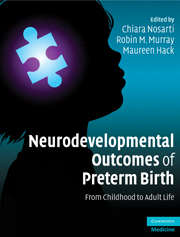Book contents
- Frontmatter
- Contents
- List of contributors
- Preface
- Section 1 Introduction
- 1 Epidemiology of preterm birth
- 2 The changing face of intensive care for preterm newborns
- 3 Clinical outcome: neurological sequelae following preterm birth
- Section 2 Neuroimaging
- Section 3 Behavioral outcome
- Section 4 Neuropsychological outcome
- Section 5 Applied research
- Section 6 Conclusions
- Index
1 - Epidemiology of preterm birth
from Section 1 - Introduction
Published online by Cambridge University Press: 06 July 2010
- Frontmatter
- Contents
- List of contributors
- Preface
- Section 1 Introduction
- 1 Epidemiology of preterm birth
- 2 The changing face of intensive care for preterm newborns
- 3 Clinical outcome: neurological sequelae following preterm birth
- Section 2 Neuroimaging
- Section 3 Behavioral outcome
- Section 4 Neuropsychological outcome
- Section 5 Applied research
- Section 6 Conclusions
- Index
Summary
Introduction
In humans, pregnancy normally lasts nine months, ending with term birth after approximately 40 gestational weeks. Preterm birth is arbitrarily defined as delivery before 37 weeks, and could be further classified as moderately, very or extremely preterm, occurring at 32–36, 28–31, and ≤ 27 weeks, respectively.
Historically, there has been some confusion regarding the diverse concepts of “low birth weight” and “preterm birth.” In 1946, the American obstetrician Raymond D McBurney stated on a congress in San Francisco “… it is extremely annoying to have a pediatrician insist that the baby is premature because it may weigh only … five pounds” [1]. McBurney correctly emphasized that birth weight is not only a function of gestational age, but also fetal growth.
In research, the definitions of low, very low and extremely low birth weight (birth weights of < 2500 g, < 1500 g, and < 1000 g, respectively) have been widely used as proxys for preterm birth. However, studies defining preterm infants solely on birth weight criteria are limited by some degree of misclassification, i.e. growth restricted infants with more advanced gestational ages are probably over-represented in such studies.
In outcome research including preterm children and adults, it is important to distinguish preterm birth from intrauterine growth retardation, since gestational age and fetal growth may have differential impacts on outcome. One example is the associations between perinatal risk factors and cardiovascular disease. Studies have shown that preterm birth as well as fetal growth restriction is associated with hypertension in adulthood.
- Type
- Chapter
- Information
- Neurodevelopmental Outcomes of Preterm BirthFrom Childhood to Adult Life, pp. 1 - 16Publisher: Cambridge University PressPrint publication year: 2010
- 4
- Cited by



